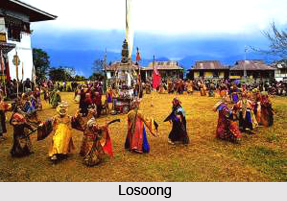 Losoong marks the end of the harvest season and also the end of the tenth month of the Tibetan Year. As it falls in the eleventh month of the Tibetan calendar it is not the real New Year in the sense of the word. This is also known as Sonam Lossar. As a matter of fact this can be called as an agricultural New Year when rice and grains are plentiful and the weather is moderate in sharp contrast to the actual New Year Lossar. This falls in a lean season and when it is extremely cold. Before Losoong monks in the monasteries perform a ceremony called Gutor. Kagyed i.e. Eight teachings of the Guru dance forms an important part of the Gutor ceremony and is held on the 28th day of the 1lth month i.e. December. This festivals is celebrated at the monasteries at Enchey, Palace i.e. Tsulakhang, Phodong and old Rumtek. The other religious dances or Chaams that are performed prior to Losoong are Rolchaam or cymbal dance, Tshamche i.e. animal headed mask dance, Shyak i.e. dance of horned animals, Namding i.e. dance of winged animals, Thakshobalap i.e. dance of the beasts of prey, Hdur i.e. skeleton dance, shanag i.e. black hat dance, Thoma Tshoglen i.e. dance of wrathful deities and Shawa chaam i.e. stag dance. The dances symbolize the exorcizing of the evil spirits of the year and the welcoming of the good spirits of the New Year. They also essentially represent the victory of the good over evil. The Head Lama or Dorjee Lopen of the Monastery and the Music conductor or Rolpon supervises the performance of the dances. Men become gods during the dances and don attires with mystical symbols.
Losoong marks the end of the harvest season and also the end of the tenth month of the Tibetan Year. As it falls in the eleventh month of the Tibetan calendar it is not the real New Year in the sense of the word. This is also known as Sonam Lossar. As a matter of fact this can be called as an agricultural New Year when rice and grains are plentiful and the weather is moderate in sharp contrast to the actual New Year Lossar. This falls in a lean season and when it is extremely cold. Before Losoong monks in the monasteries perform a ceremony called Gutor. Kagyed i.e. Eight teachings of the Guru dance forms an important part of the Gutor ceremony and is held on the 28th day of the 1lth month i.e. December. This festivals is celebrated at the monasteries at Enchey, Palace i.e. Tsulakhang, Phodong and old Rumtek. The other religious dances or Chaams that are performed prior to Losoong are Rolchaam or cymbal dance, Tshamche i.e. animal headed mask dance, Shyak i.e. dance of horned animals, Namding i.e. dance of winged animals, Thakshobalap i.e. dance of the beasts of prey, Hdur i.e. skeleton dance, shanag i.e. black hat dance, Thoma Tshoglen i.e. dance of wrathful deities and Shawa chaam i.e. stag dance. The dances symbolize the exorcizing of the evil spirits of the year and the welcoming of the good spirits of the New Year. They also essentially represent the victory of the good over evil. The Head Lama or Dorjee Lopen of the Monastery and the Music conductor or Rolpon supervises the performance of the dances. Men become gods during the dances and don attires with mystical symbols.
The orchestra consists of Gyaling and Kyaling, which are trumpets, dungkar or conch, nga chen or drums and rolmo and silnyen which are types of cymbals.
The Rolchaam is unique to Sikkim and was introduced by Chogyal Chakdor Namgyal. The Rolchaam is performed by 12 dancers. The twelve animals depicted in the Tshamche chaam can be mentioned as Singhi i.e. snow lion, male and female Shawas i.e. deer, Lang i.e. Bull, Shyak i.e. yak, Tel i.e. monkey, Chachug i.e. garuda, cha i.e. bird, Hookpa i.e. hawk, druk i.e. dragon, chusing i.e. crocodile, ta i.e. tiger and dul i.e. snake. The Tshamche chaam is performed amidst the reading of prayers from the Guda, which is a prayer book.
The Shanag or black hat dance is particularly impressive. This dance celebrates the killing of the trecherous King Langdarma of the Yarlung dynasty in the ninth century by a monk. The name of the monk was Pelkyi Dorjee. He killed the king using a dagger hidden in the voluminous sleeves of his garment. King Langdarma was virulently anti-Buddhist and had been prosecuting monks and destroying monasteries. The black hat dancers, who normally are in 12 number, carry phurpa or daggers in the left hand and a bandha or skull cap in the right hand. The masks used during the dances are usually made of wood but some dancers use copper masks. In order to protect their faces from the mask`s sharp edges, the dancers wear padded caps covering the forehead, the neck and the sides of the faces. The caps are held in position by scarves. The mask is much larger than a human face and therefore the dancers see through the mouth or the nostrils of the masks.
The first day of the eleventh month marking the actual beginning of Losoong is known as Tshe Tchi. Prayers are held and the elders bless the younger members of the family by applying Chimma or flour to the head or the shoulders. On the second and third days people visit each others homes and exchange greetings. On the fourth and fifth day community feastings take place. The anti-climax of the Losoong festival is on the sixth and seventh day i.e. Nyempa Guzom, when it is considered inauspicious to venture out. People generally stay at home and rest accompanied by a few bouts of drinking and gambling.



















